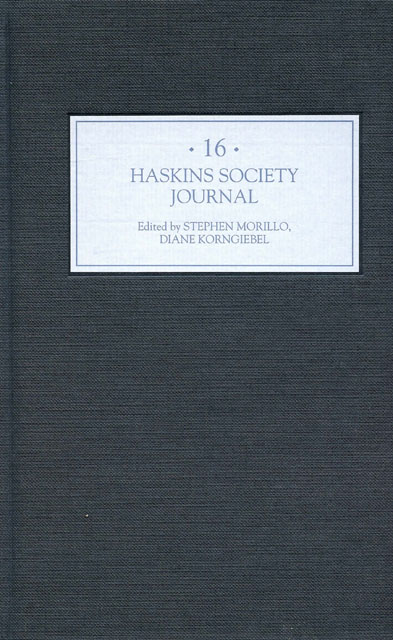Book contents
- Frontmatter
- Contents
- Editor’s Note
- Abbreviations
- 1 Hallucinations of Power: Climates of Fright in the Early Twelfth Century
- 2 Sites and Occasions of Peacemaking in England and Normandy, c. 900–c. 1150
- 3 Trans-border Transactions: Patterns of Patronage in Anglo-Norman Wales
- 4 Lay Piety, Confessional Directives and the Compiler’s Method in Late Anglo-Saxon England
- 5 Furor Teutonicus. A Note on Ethnic Stereotypes in Suger’s Deeds of Louis the Fat
- 6 Law and Theology in Gilbert of Foliot’s (c. 1105/10–1187/88) Correspondence
- 7 A Lost Law of Henry II: The Assize of Oxford and Monetary Reform
- 8 The Renaissance of the Twelfth Century Before Haskins
- 9 ‘Hobbes’, ‘Dogs’ and Politics in the Ireland of Lionel of Antwerp, c. 1361–6
3 - Trans-border Transactions: Patterns of Patronage in Anglo-Norman Wales
Published online by Cambridge University Press: 23 March 2023
- Frontmatter
- Contents
- Editor’s Note
- Abbreviations
- 1 Hallucinations of Power: Climates of Fright in the Early Twelfth Century
- 2 Sites and Occasions of Peacemaking in England and Normandy, c. 900–c. 1150
- 3 Trans-border Transactions: Patterns of Patronage in Anglo-Norman Wales
- 4 Lay Piety, Confessional Directives and the Compiler’s Method in Late Anglo-Saxon England
- 5 Furor Teutonicus. A Note on Ethnic Stereotypes in Suger’s Deeds of Louis the Fat
- 6 Law and Theology in Gilbert of Foliot’s (c. 1105/10–1187/88) Correspondence
- 7 A Lost Law of Henry II: The Assize of Oxford and Monetary Reform
- 8 The Renaissance of the Twelfth Century Before Haskins
- 9 ‘Hobbes’, ‘Dogs’ and Politics in the Ireland of Lionel of Antwerp, c. 1361–6
Summary
In the ‘Pennal’ letter of 1406 Owain Glyn D¤r set out his programme for the creation of an independent Welsh church. Among this manifesto's clauses was the call for the immediate end to appropriation of Welsh parishes to English religious houses and for their advowsons to be restored to the original patrons. Though there was undoubtedly widespread contemporary concern, by no means confined to Wales, at the acceleration of appropriations by monasteries as a response to economic pressures, particularly during the second half of the fourteenth century, and though appropriations within Wales were certainly not limited to English abbeys, Owain's complaint reflected a discontent whose roots are found nearly three centuries earlier as English and Norman monasteries began their colonization of the Welsh Church.
In 1119 Bishop Urban of Llandaf wrote to Pope Calixtus II complaining of the sad state of his diocese and asking for papal support in its defence. He described the depredations that had commenced during his predecessor Herewald's episcopate: he went on to blame the neighbouring bishops of Hereford and St Davids, and attributed the despoliation to ‘lay power and monastic invasion’ (‘tam laicali potestate quam monachorum invasione’). The papal response was almost immediate; in October 1119 Calixtus issued five bulls in favour of Llandaf, taking the see under papal protection. One ordered thirteen named lords in the diocese to restore what they had seized. This list is a roll-call of the great men of the new settlement. But one name is conspicuous by its absence. No mention is made of the greatest magnate of them all, Earl Robert of Gloucester, who had been granted the lordship of Glamorgan, previously held by Robert fitzHamo, some time following Robert's marriage to Mabel, fitzHamo's daughter, in 1107. It has recently been pointed out that the interests of most of those lords named in 1119 lay predominantly outside Glamorgan. They could therefore be seen as peripheral to the Llandaf heartland. However, in 1126 a concord was made between Bishop Urban of Llandaf and Earl Robert. In return for Robert's confirmation of specific lands and rights to Urban securing the integrity of his demesne at Llandaf Urban agreed to waive all claims against the earl's tenants for any lands they had seized. The agreement's witnesses testify to its solemnity and status.
- Type
- Chapter
- Information
- The Haskins Society Journal2005. Studies in Medieval History, pp. 27 - 46Publisher: Boydell & BrewerPrint publication year: 2006
- 1
- Cited by



